Family Rules Sign
This free printable family rules sign comes in 18 different designs! We have written 10 sample family rules on each poster, but you can edit each of the rules.
Use the free family house rules template to create your own personalized family signs by adding your family name to the title and editing any house rules that you want to change. You can either change the text to include your personal house rules, edit some of the rules, or use as-is. Don’t forget to change your family name.
Free Printable House Rules Sign
Scroll down to see each of the designs until you find the one you like best. Scroll down to the bottom of the page to find tips on how to decide on your family rules and how to ensure that they are effective.
On the above template, you can edit the title as well. You can, therefore, use it for house rules in other places such as Airbnb. In the other versions on this page, you can edit all text except “Family Rules”.
What are family rules?
Family rules are guidelines and expectations established within a family to promote harmony, respect, and a positive family dynamic. These rules help set boundaries, define appropriate behavior, and create a sense of security and consistency within the household.
They enable all members of the family to know what is expected of them in order to get along and prevent arguments. They also help parents to be more consistent. A few clear and specific rules usually work better than a long list, especially for younger kids. As kids get older, you can add more rules. To add additional rules, simply visit this site again and click on “add text”. If you want to add a lot of rules, you might need to move the existing family rules up the page or make the font smaller to fit more lines on the page.
Sample family rules
Family rules can vary depending on family values, cultural background, and individual circumstances, but here are some common examples of family rules:
- Be respectful: Treat each family member with kindness and consideration, using polite language and gestures.
- Communicate openly: Encourage open and honest communication within the family, allowing everyone to express their thoughts and feelings.
- Show empathy and understanding: Be supportive and understanding towards each other’s needs and emotions.
- Be responsible: Complete assigned chores or tasks and take responsibility for personal belongings.
- Use devices mindfully: Set guidelines for device usage, including screen time limits and appropriate online behavior.
- Participate in family activities: Engage in family bonding activities and spend quality time together.
- No shouting or yelling: Avoid raising voices in conflicts, and find calm and respectful ways to resolve disagreements.
- Respect personal space: Allow family members to have privacy and personal time when needed.
- No hitting or physical aggression: Promote non-violent conflict resolution and discourage any form of physical harm.
- Help each other: Encourage siblings to support and assist one another when needed.
- Respect mealtime rules: Follow table manners and eat together as a family when possible.
- No name-calling or disrespect: Avoid using hurtful language and show respect when expressing opinions or frustrations.
- Be on time: Teach punctuality and the importance of honoring commitments and schedules.
- Practice good hygiene: Encourage cleanliness and personal grooming habits.
- Apologize and forgive: Teach the value of apologizing when mistakes are made and being willing to forgive and move forward.
Family rules can evolve over time as the family grows and changes. It’s essential to involve all family members in creating these rules to ensure everyone feels heard and included. Consistency in enforcing these rules helps reinforce positive behaviors and contributes to a healthy and nurturing family environment.
Why families need rules
Families need rules for several important reasons:
- Establishing Boundaries: Rules set clear boundaries and expectations for behavior within the family. They help define what is acceptable and what is not, promoting a sense of structure and order.
- Promoting Respect: Rules encourage respectful interactions among family members. By treating each other with kindness and consideration, family relationships can thrive.
- Ensuring Safety: Rules help ensure the safety and well-being of family members. For example, rules about not running near the pool or wearing seatbelts in the car protect against accidents.
- Building Responsibility: Having rules that assign responsibilities, such as chores, helps teach children about responsibility, accountability, and contributing to the family unit.
- Fostering Communication: Rules can encourage open communication within the family. By discussing rules together, family members can express their needs and feelings, leading to better understanding and compromise.
- Strengthening Family Bonds: Shared rules and responsibilities create a sense of unity and solidarity within the family. Following rules together promotes teamwork and cooperation.
- Teaching Values: Family rules often reflect the values and principles that parents want to instill in their children. They serve as a practical way to teach ethical behavior and moral values.
- Developing Self-Discipline: Abiding by rules helps children develop self-discipline and self-control, essential skills for success in various aspects of life.
- Resolving Conflicts: Rules provide a framework for resolving conflicts in a fair and constructive manner. When disagreements arise, family members can refer to established rules to find solutions.
- Providing a sense of stability and security: Having consistent rules and routines can provide a sense of stability and security for children, promoting their emotional well-being.
- Preparing for the Future: Learning to follow rules and understand consequences prepares children for life outside the family, where rules and expectations exist in various settings.
Overall, family rules create a positive and nurturing environment where family members can grow, learn, and develop healthy relationships. When enforced with love and understanding, family rules contribute to the overall happiness and well-being of the family unit.
How to enforce house rules
Enforcing family rules effectively requires a balance of firmness, consistency, and understanding. Here are some strategies to help you enforce family rules in a positive and constructive manner:
- Be Clear and Communicate: Clearly explain the family rules to all members and discuss why they are important. Make sure everyone understands the consequences of not following the rules.
- Lead by Example: Model the behavior you want to see in your family. Children often learn by observing their parents, so demonstrating adherence to the rules reinforces their importance.
- Be Consistent: Consistency is key to successful rule enforcement. Apply the rules consistently for all family members and follow through with consequences when rules are broken.
- Use Positive Reinforcement: Praise and reward family members when they follow the rules. Positive reinforcement encourages good behavior and motivates everyone to abide by the rules.
- Set Reasonable Consequences: Ensure that the consequences for breaking rules are fair and appropriate. Avoid overly harsh punishments, as they can lead to resentment and defiance.
- Give Warnings: Offer a verbal warning when someone breaks a rule. This provides an opportunity for self-correction before consequences are applied.
- Provide Time for Reflection: For more significant rule violations, consider giving family members time to reflect on their actions and consider how they can improve their behavior.
- Encourage Open Communication: Create a safe space for family members to discuss the rules, their feelings, and any challenges they may face in following them.
- Collaborate on Solutions: Involve family members in finding solutions to any rule-related problems. This fosters a sense of ownership and responsibility.
- Be Patient and Understanding: Enforcing family rules may involve occasional setbacks or mistakes. Be patient and offer support when needed.
- Reevaluate Rules as Needed: As your family grows and changes, some rules may need adjustments. Reevaluate and update rules as necessary to fit your family’s evolving dynamics.
- Focus on Teachable Moments: Use rule-breaking incidents as opportunities for learning and growth. Discuss why the rule exists and how it contributes to a harmonious family environment.
Remember that enforcing family rules is not about exercising control but about promoting a positive and loving environment for everyone. It’s essential to enforce rules with empathy and understanding while still maintaining consistent expectations for behavior. By doing so, you can help foster a strong and supportive family bond.
Tips
Involve all family members when creating the list
According to raisingchildren.net.au, it’s important to involve all family members as much as possible when developing family rules. They suggest that you talk to your children about why your family needs the rules. As children get older, they can take a bigger part in deciding what the rules should be, as well as the consequences for breaking them. When you involve pre-teens and teenagers in setting the rules, it makes them take responsibility for their own behavior.
Decide not only on the rules but also on the consequences if a rule is broken
According to raisingchildren.net.au, family rules are only effective when you back them up. This means that when you decide on a rule, you also need to decide ahead of time what will happen if someone breaks the rule. For younger children, you can simply remind your child of the rule when it is broken and give her another chance, but it will be more effective to implement the consequence you’ve agreed on. For teenagers, agreement on a clear set of house rules and consequences will help them develop both self-discipline and autonomy.
Since all printables on this site are free, you can make as many copies as you want. We suggest that you make two versions of the family house rules sign. One sign with a list of the rules that you can frame and hang up. Another version with consequences for each rule. You can give each person a copy of this version.
How to use the family rules sign for children who can’t read
When younger children can’t read yet, you can add a photo of each rule next to the rule. To add a photo, select the template that you will use and then click on “add photo”. Take photos of your child or family that will help her understand each rule.

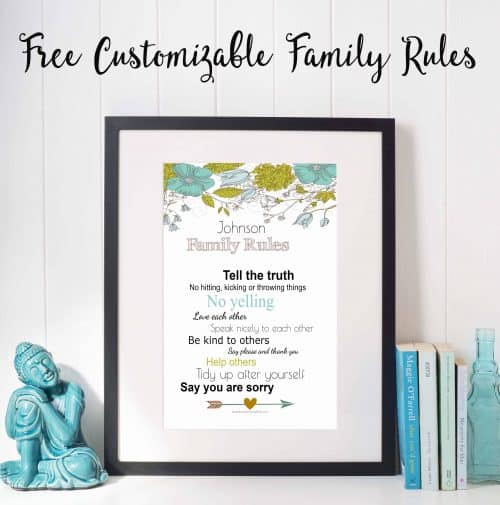
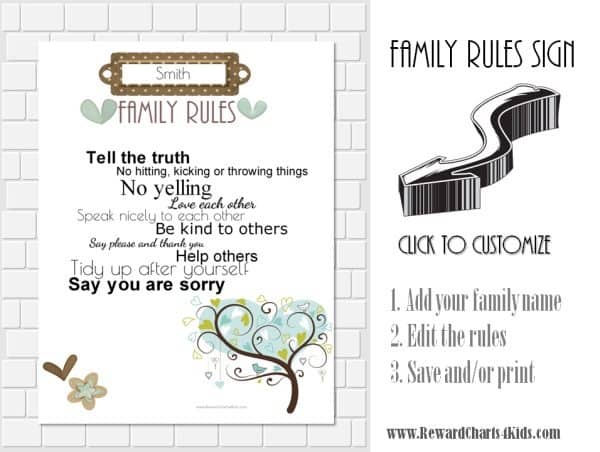
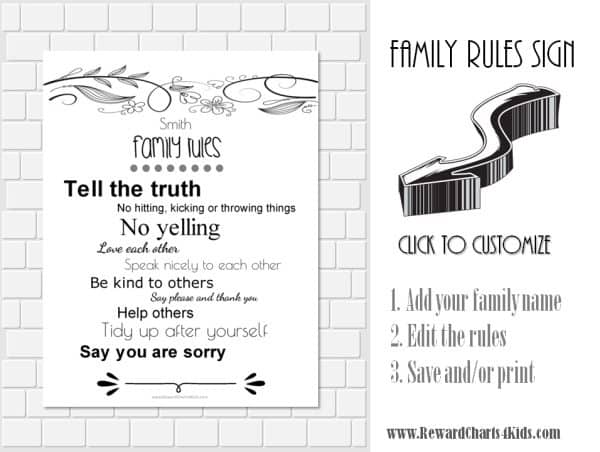
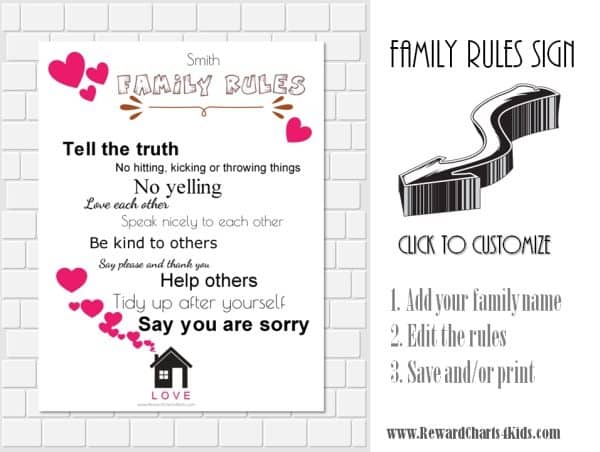
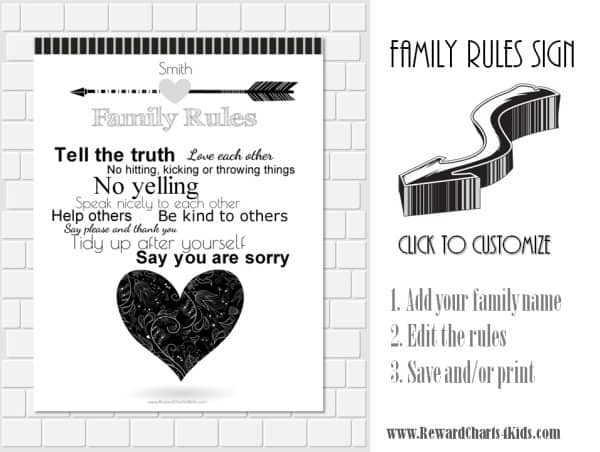
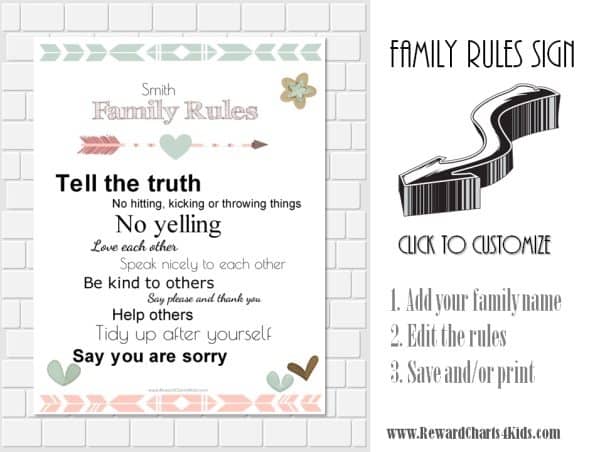
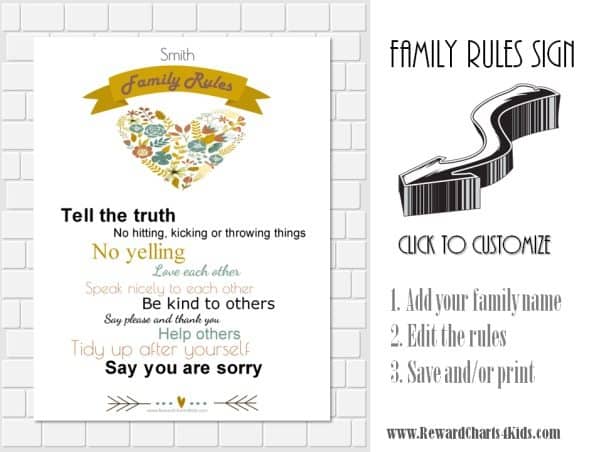
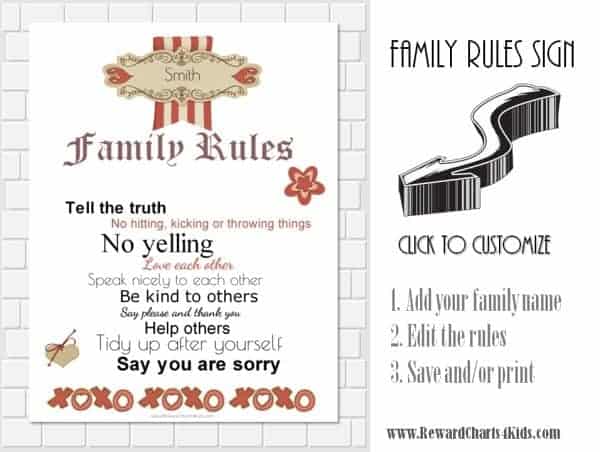
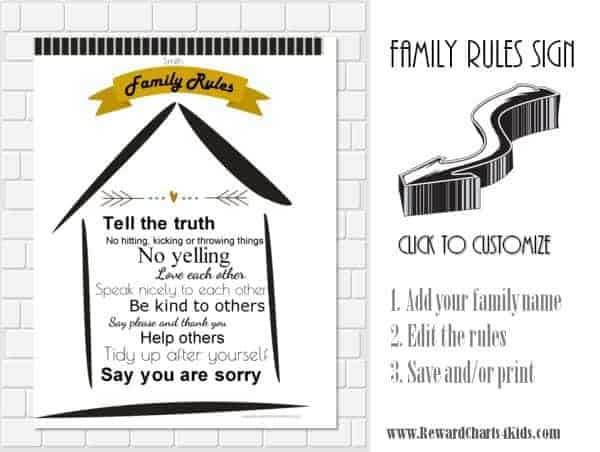
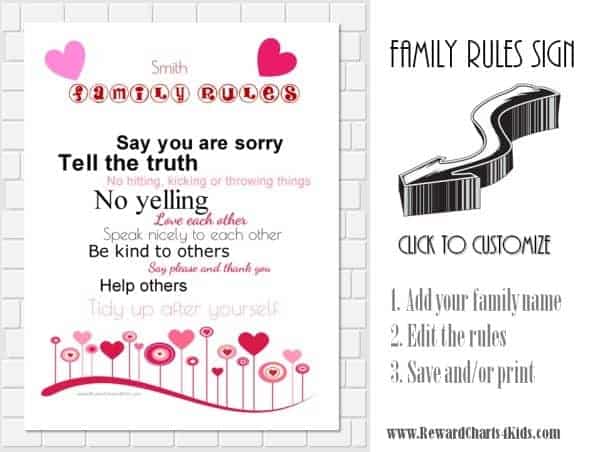
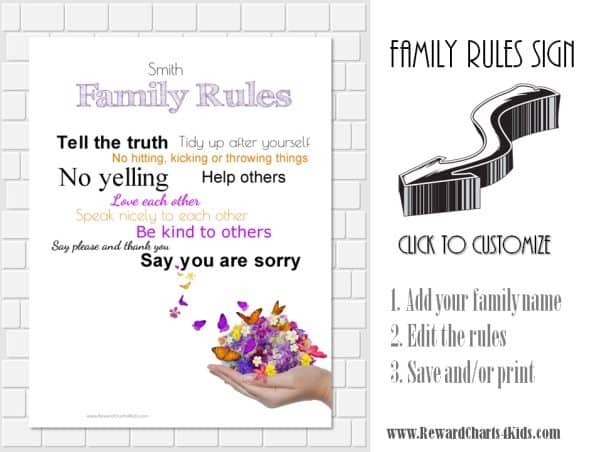
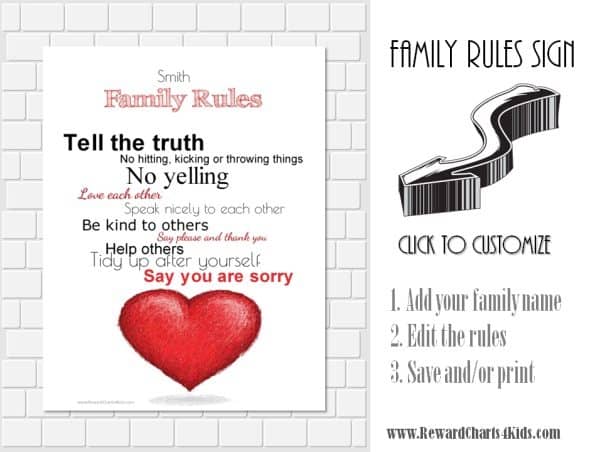
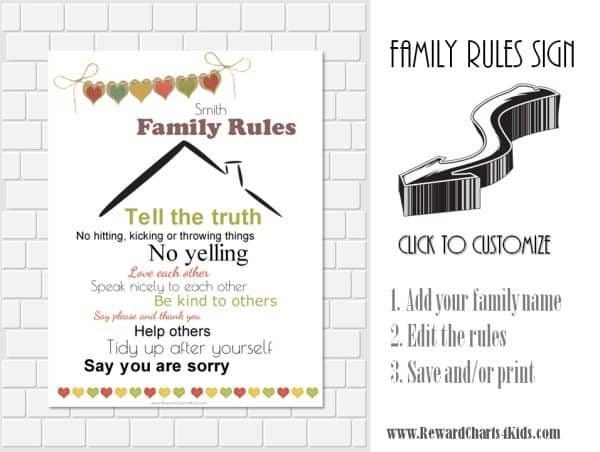
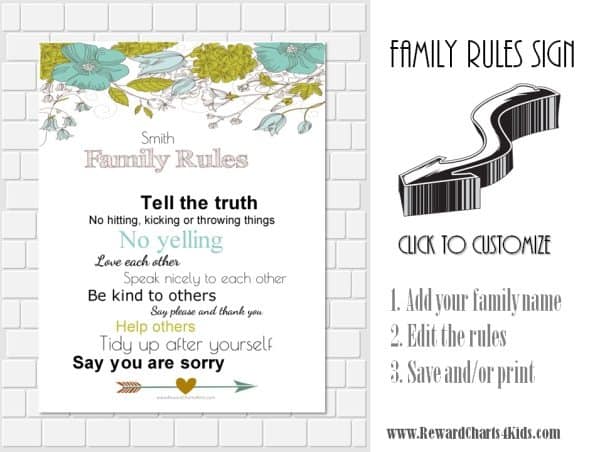
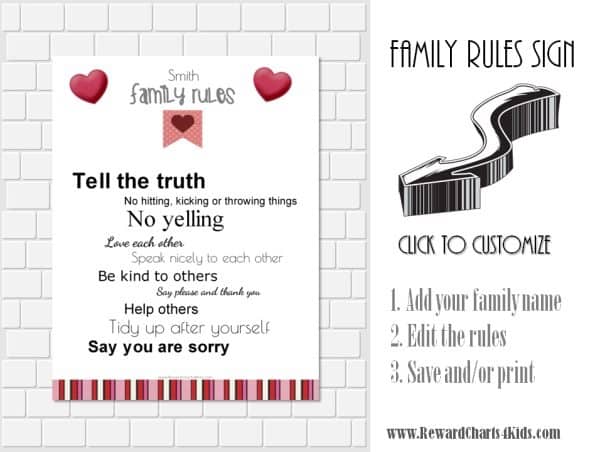
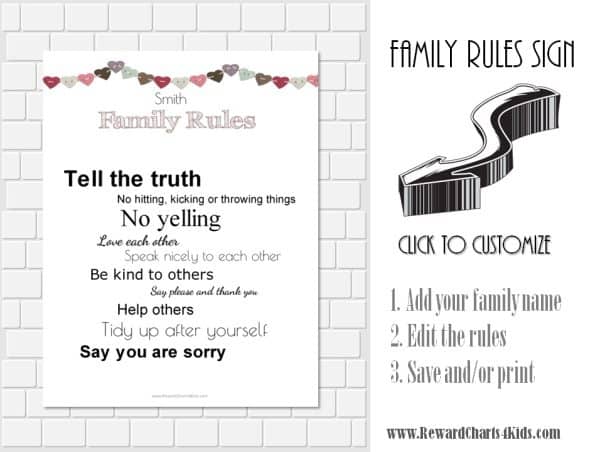
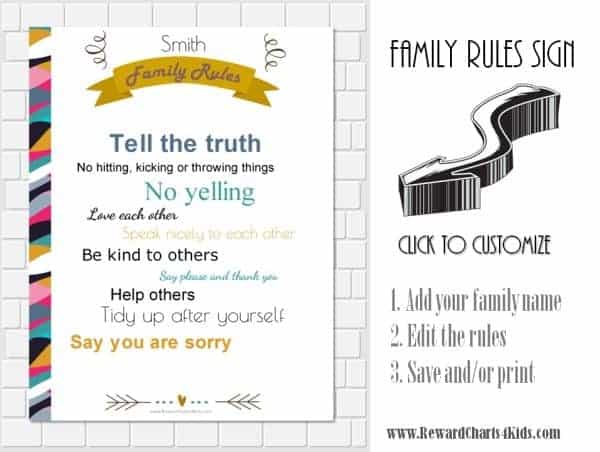
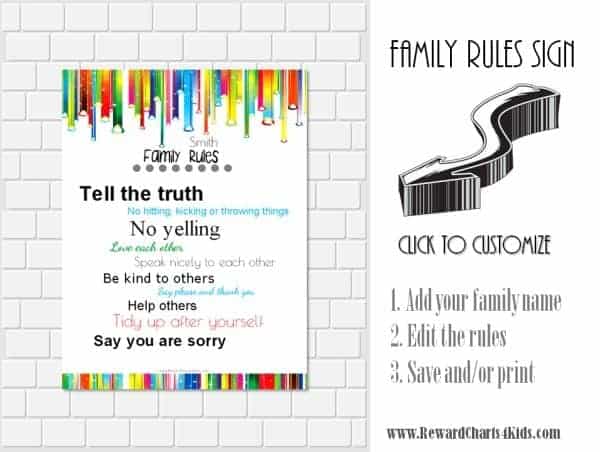
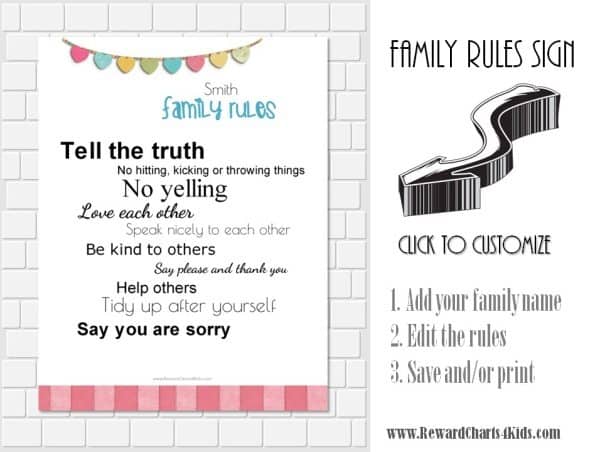
Speak nicely to each other
Help others
Say you are sorry
These are awesome! Have one posted on our fridge and in our girls room as a reminder. 🙂
No throwing, kicking and hitting things.
Eatting independently.
No climbing on the couch